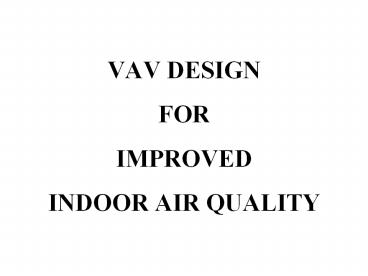VAV DESIGN FOR IMPROVED INDOOR AIR QUALITY - PowerPoint PPT Presentation
Title:
VAV DESIGN FOR IMPROVED INDOOR AIR QUALITY
Description:
VAV DESIGN FOR IMPROVED INDOOR AIR QUALITY Air conditioning is the control of the humidity of air by either increasing or decreasing its moisture content. – PowerPoint PPT presentation
Number of Views:143
Avg rating:3.0/5.0
Title: VAV DESIGN FOR IMPROVED INDOOR AIR QUALITY
1
VAV DESIGNFORIMPROVEDINDOOR AIR QUALITY
2
- Air conditioning is the control of the humidity
of air by either increasing or decreasing its
moisture content. Added to the control of
humidity is the control of temperature by either
heating or cooling the air, the purification of
the air by washing or filtering the air, and the
control of air motion and ventilation. - Willis H. Carrier
3
(No Transcript)
4
- COMPLETE AND PERFECT MIXING OCCURS BETWEEN ALL OF
THE ROOM AIR AND THE SUPPLY AIR - THE RETURN AIR IS LEAVING THE ROOM AT THE
TEMPERATURE OF THE ROOM - THE INTRODUCTION OF THE SUPPLY AIR GENERATES AN
ACCEPTABLE AMBIENT AIR VELOCITY IN THE ROOM - EITHER THE FLOW RATE (CFM) OR THE DT OR SOME
COMBINATION OF BOTH CAN BE VARIED TO SPAN THE
ENTIRE RANGE OF CAPACITY REQUIREMENTS - ADEQUATE VENTILATION AIR MUST BE CIRCULATED
THROUGH THE SPACE AT ALL TIMES TO REMOVE THE
CONTAMINENTS
5
q CFM (1.08) (tr - ts)
6
HEAT-COOL-OFFDUAL STREAMREHEAT
7
(No Transcript)
8
DUAL STREAM qs CFM (1.08) (tr
- ts) CONSTANT CFM, VARIABLE DTEXAMPLES
DOUBLE DUCT MULTIZONE
9
(No Transcript)
10
(No Transcript)
11
TERMINAL REHEAT qs CFM (1.08) (tr
- ts) CONSTANT CFM, VARIABLE DT
12
(No Transcript)
13
(No Transcript)
14
VARIABLE AIR VOLUME (VAV) qs CFM (1.08)
(tr - ts) VARIABLE CFM, CONSTANT DT
15
(No Transcript)
16
(No Transcript)
17
(No Transcript)
18
(No Transcript)
19
(No Transcript)
20
Poor mixing of supply airInadequate ambient air
circulationDumpingReduced ventilation rates
as load decreases
21
(No Transcript)
22
(No Transcript)
23
(No Transcript)
24
(No Transcript)
25
(No Transcript)
26
(No Transcript)
27
- The dehumidification of the outdoor ventilation
air and the space can be separated from the space
temperature control - The ventilation supply need not be integrated
with the space temperature control - The Economizer System is an option
28
(No Transcript)
29
RULES
- The building envelope must be well defined and
must be secure from any opportunity for mass air
flow at conditions different from the indoors
and must prevent migration of water vapor due to
vapor pressure difference - The envelope itself must prevent vapor migration
by use of continuous vapor barriers properly
located - The point at which outdoor air is introduced into
the space must be well defined - No air should be introduced into the space at
moisture conditions different from those desired
in the space
30
(No Transcript)
31
- The conditioned makeup or ventilation air can be
supplied to and distributed to the space in a
separate duct and distribution system, or - The makeup air can be introduced into the return
side of the recirculating units - There could be a single makeup air unit for a
building with multiple recirculating units, or - There could be a makeup air unit for each
recirculating unit
32
- Cost
- Load dynamics
- Occupancy patterns
- Ratio of Outdoor Air to Recirculated Air
33
(No Transcript)
34
(No Transcript)
35
(No Transcript)
36
(No Transcript)
37
- In warm humid climates the age-old problem of
poor part-load humidity control in the spaces was
solved, and - The major sources of indoor air quality problems
are eliminated. These are - Uncontrolled microbial growth
- Poor air circulation and mixing
- Inadequate ventilation air quantities
38
DESIGN GUIDELINES
- UNDERSTAND THE LOAD AND DESIGN THE SYSTEM TO
SERVE THE ANTICIPATED LOAD PLATEAUS - CONTROL THE BUILDING AT ALL TIMES
- PROVIDE A SEPARATE MINIMUM VENTILATION AIR
CONDITIONING SYSTEM OR UNIT (PARTICULARLY WITH
DIRECT EXPANSION)
39
- USE THE SIMPLEST BUT HIGHEST QUALITY VAV TERMINAL
POSSIBLE - USE FAN POWERED TERMINALS SPARINGLY
- DESIGN AN AIR DISTRIBUTION SYSTEM THAT WILL
PROVIDE EFFECTIVE MIXING WITHOUT DUMPING, DOWN TO
THE MINIMUM COOLING LOAD THE SYSTEM WILL EVER SEE
ON AN OCCUPIED CYCLE, OR THE MINIMUM DICTATED BY
THE EFFECTIVE PERFORMANCE
40
- BELOW THE MINIMUM PERFORMANCE QUANTITY, IF THE
LOAD CONTINUES TO DROP, REHEAT IS NECESSARY - RESET THE COLD DECK IF THIS CAN BE DONE WITH OUT
ADDING TOO MUCH COMPLEXITY - DESIGN THE AIR HANDLING SYSTEM FOR THE LOWEST
TOTAL PRESSSURE THAT IS ECONOMICALLY FEASIBLE
(TRY TO HOLD THE UPPER LIMIT AT 4 w.c.)
41
- DONT DEPEND ON DIRECT DIGITAL CONTROL TO SOLVE
PROBLEMS THAT THE DESIGNER DOESNT UNDERSTAND































